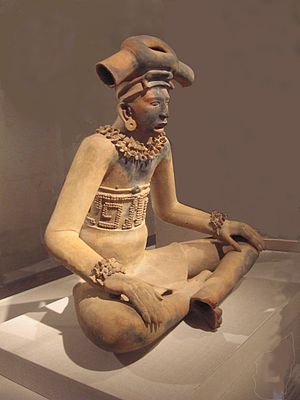

Remojadas (Spanish pronunciation: [remoˈxaðas]) is a name applied to a culture, an archaeological site, as well as an artistic style that flourished on Mexico's Veracruz Gulf Coast from perhaps 100 BCE to 800 CE. The Remojadas culture is considered part of the larger Classic Veracruz culture. Further research into the Remojadas culture is "much needed". The archaeological site has remained largely unexplored since the initial investigations by Alfonso Medellin Zenil in 1949 and 1950.
Figurines
Remojadas is particularly known for its pottery and its hollow ceramic figurines. Thousands of these expressive and diverse figurines have been unearthed, found across a wide variety of settings, including burials and middens.

300 - 600 CE; Height: 31 in (79 cm).
Figurines portray deities, rulers, and commoners, as well as many types of animals including dogs and deer. Of particular note are the curious childlike Sonrientes (smiling face) figurines and faces. Many of the figurines of this period function as flutes, whistles, and ocarinas. Some animal figurines, interpreted as toys or more likely ritual items, are equipped with wheels, one of the few recorded instances of the application of wheel technology in the pre-Columbian Americas.
Many figurines have filed teeth, representing a common practice in the Remojadas culture. The earliest figurines were handmade while the later ones were created using molds. In style and in other ways, the figurines have a close kinship with Maya figurines.
Sonrientes
The Sonrientes (smiling faces) are the most well-known of Remojadas figurines, featuring wide smiles on curiously shaped—almost triangular—faces. Often the heads are disembodied. Other times they are attached to childlike bodies with outstretched arms and displayed palms. The smile is rather formalised, usually showing teeth and, on occasion, a tongue sticking out between the teeth.
Male sonrientes are nude or wear loinclothes. Females wear skirts. Both are usually adorned with pectoral bands and/or necklaces, as well as some type of headdress. The headdress, and often the skirts, display a glyph-like emblem or a stylized animal.
Smiling figurines are rare in Mesoamerican art, and the sheer number of Sonrientes figurines likely attests to their special role in the Remojadas society, although what that role might be has produced much speculation. Some researchers see the characteristic smile as being hallucinogenically produced or perhaps the result of consumption of the alcoholic pulque. One researcher boldly states that they are "undoubtedly related to the cult of the dead". However, Mary Ellen Miller and Karl Taube find that "it is more likely that many of the smiling figures represent performers".
Notes

Height: 7 in. (18 cm); length: 8 in (21 cm).
- Among others, Medillin Zenil, p. 168) who says recovered artifacts "reveal a strong technological and ideological relationship" with Central Veracruz.
- Coe (2002), p.113.
- Covarrubias, p. 193.
- Diehl and Mandeville, p. 243.
- Coe (2002), p. 119.
*Medillin Zenil, p. 168. - Medillin Zenil, p. 163-168.
- Davies, p. 91.
- Metropolitan Museum of Art.
- Ochoa, p. 68.
- Miller & Taube, p. 156.
- Coe (2002), p. 119.
References
- Coe, M; Snow, D; Benson, E; (1986) Atlas of Ancient America; Facts on File, New York.
- Coe, M.D. (2002); Mexico: From the Olmecs to the Aztecs Thames and Hudson, London.
- Covarrubias, Miguel (1957) Indian Art of Mexico and Central America, Alfred A. Knopf, New York.
- Davies, Nigel (1983) The Ancient Kingdoms of Mexico, Penguin Books, London.
- Diehl, Richard A.; Mandeville, Margaret D. (1987), "Tula, and wheeled animal effigies in Mesoamerica", in Antiquity, vol. 61, no. 232; July 1987.
- Medillin Zenil, Alfonso; Frederick A. Peterson (1954) "A Smiling Head Complex from Central Veracruz, Mexico" in American Antiquity, Vol. 20, No. 2. (Oct., 1954), pp. 162–169.
- Metropolitan Museum of Art, "Smiling" Figure, URL:http://www.metmuseum.org/Collections/search-the-collections/50006048. Accessed: 2012-02-12. (Archived by WebCite® at https://www.webcitation.org/65OuuK4eg)
- Miller, Mary Ellen; Karl Taube (1993). The Gods and Symbols of Ancient Mexico and the Maya. London: Thames and Hudson. ISBN 0-500-05068-6.
- Ochoa, Lorenzo (2000) "Remojadas" in The Oxford Encyclopedia of Mesoamerican Cultures ed. Carrasco, Davíd, Oxford University Press.
- Speight, Charlotte; Toki, John (2003) Hands in Clay: An Introduction to Ceramics, McGraw-Hill, New York.
External links
- Remojadas figurine at the Metropolitan Museum in New York City.
- An early Remojadas animal figurine.
- Comprehensive site on Remojadas and other pre-Columbian Wheeled Artifacts.
18°59′N 96°19′W / 18.983°N 96.317°W / 18.983; -96.317
Categories: